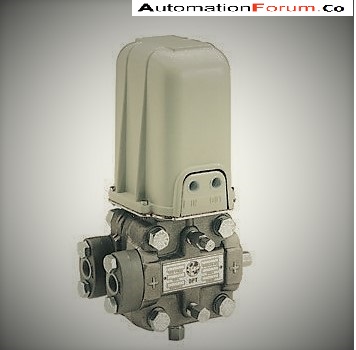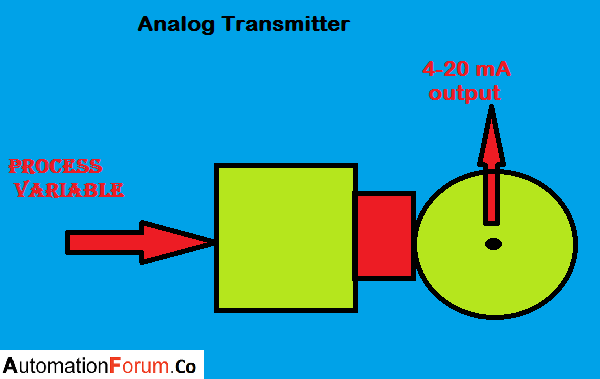What is Transmitter?
Transmitters are instruments used to generate and send electromagnetic waves which includes message or signal. A transmitter produces radio waves with the help of Antenna. Transmitter itself combines a sensor and the sensor measures the process variable and generates proportional signal.
What is the working principle of Transmitter?
The working principle of transmitter can be defined as it measures the process variable provided and generates a proportional signal to be transmitted. For a pressure transmitter, the pressure sensor converts the mechanical value into an electrical signal. In case of level transmitter it works on the principle of Radar. Level transmitters are mounted on the top of the tank, which is filled with liquid. The transmitter send a radar signal into the liquid and receives the reflection of the signal. For liquids in pipelines, Flow transmitters are used. The flow transmitter converts the results into a proportional electrical signal. The short form of transmitter is TX.
How Transmitters are classified?
Transmitters are broadly classified into:
Pneumatic transmitter:

In a pneumatic transmitter, pneumatic signals that is air is used for transmission operation. A pneumatic transmitter gives output to the corresponding input signal. The commonly used pneumatic range in industries are 3-15psi.
Analog transmitter:

In analog transmitter, analog signal standards are used for communication. The output will be an electrical signal (current or voltage) that is in the range of 4-20milliamps. 4 represents the lower range and 20 represents the higher range.
Digital Transmitters:
Most of the digital transmitters are referred to as smart transmitters. Digital transmitters produces digital signal that are combined to enhance communication. The inbuilt microprocessor in digital transmitters gives diagnostic property and also good signal conditioning processes. They combine the digital signals in a variety of ways such as Field bus communication protocols. Digital signals are discrete levels or values.
Electronic Transmitters:
Electronic transmitters are classified into 2-wire, 3-wire and 4-wire based on the number of wire necessary to provide transmitter power.
In addition to this, based on the parameters used in process control like pressure, level, temperature, flow level, transmitters are again classified into:
Pressure transmitters:

- Absolute pressure transmitter: The pressure relative to perfect vacuum is measured by absolute pressure transmitter.
- Gauge pressure transmitter: The pressure relative to atmospheric pressure in a specific region is measured by gauge pressure transmitter.
- Differential pressure transmitter: When two or more pressure is introduced as inputs, the difference in pressure is measured by differential pressure transmitter. For example the flow or level in a pressurized vessel is measured through differential pressure transmitter.
Level transmitters
Level transmitters are used to measure liquid level, solid level within a space. These are again classified into,
- Point level transmitter
- Continuous level transmitter
- Ultrasonic level transmitter
- Conductive level transmitter
- Hydrostatic based level transmitter
- Pneumatic level transmitter
Temperature transmitters:
These transmitter utilises the temperature ranges in process industries.
- Thermocouple type transmitter: In this type of transmitters, with the help of thermocouple the emf (electromotive force) generated by change in process temperature is calculated.
- RTD type transmitter:A change in electrical resistance in RTD is formed due to changes in process temperature. Hence RTD calculates the temperature.
Flow transmitters:
Flow transmitters are used to indicate and measure the flow in process control. A flow sensor will be there, which gives the signal flow to the transmitter to give an output 4 -20 milliamps that represents the flow process change.
What is FM Transmitter?

FM Transmitters are used for transmitting FM signal. Transmitters are those devices which send frequency modulated wave through a band.
What is receiver?

The working of receiver is just opposite to that of a transmitter. For example, in a radio receiver, it uses an antenna to capture the radio waves, processes those waves to get the desired frequency .
What is Transducer?How transducers classified?
The non-electrical quantity is converted into an electrical form for using electrical methods and techniques for measurement, manipulation and control. The device which when actuated, transforms energy from one form to another is called a transducer.
Transducers are broadly classified into:
- Active and Passive
- On the basis of principle used as Capacitive, Resistive, Inductive.
- Primary and Secondary
- Analog and Digital
- Transducers and Inverse Transducers.
Comparison between Transducer and Transmitter?
The difference between transducer and transmitter are as follows:
- The mode of operation is almost same for both transducer and transmitter. That is a transducer sends an electrical signal in the range of volts (V) or mV. A transmitter sends an electrical signal in milliamps range.
- The general configuration of a measurement transducer consists of a sensing element combined with a driving element. Here driving element refers to transmitter. The block diagram illustrates this,

- What is the difference between a pressure transmitter and a transducer?
Transducer and transmitter convert energy from one form to give a specific output. Hence, a question arises that where to use transducers and where to use transmitters? Virtually both does the same operation. The main difference is that the kind of electrical signal each sends. A pressure transducer is feasible for a situation where the process are short, that is in electronic circuit enclosure. Because they tend to be smaller in size. Also there are only very few electronic active components present. The below diagram shows a differential pressure transmitter.

The above mentioned are the main difference between a transducer and a transmitter.





